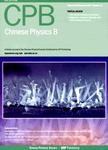Interrogation of optical Ramsey spectrum and stability study of an ^(87)Sr optical lattice clock
Interrogation of optical Ramsey spectrum and stability study of an 87Sr optical lattice clock作者机构:CAS Key Laboratory of Time and Frequency Primary StandardsNational Time Service CenterXi'an 710600China University of Chinese Academy of Sciences(CAS)Beijing 100049China
出 版 物:《Chinese Physics B》 (中国物理B(英文版))
年 卷 期:2022年第31卷第3期
页 面:306-310页
核心收录:
学科分类:07[理学] 070302[理学-分析化学] 0805[工学-材料科学与工程(可授工学、理学学位)] 0703[理学-化学] 0704[理学-天文学]
基 金:Project supported by the National Natural Science Foundation of China (Grant No. 61775220) the Key Research Project of Frontier Science of the Chinese Academy of Sciences (Grant No. QYZDB-SSW-JSC004) the Strategic Priority Research Program of the Chinese Academy of Sciences (Grant No. XDB21030100)
主 题:optical Ramsey spectrum optical lattice clock stability coherence time
摘 要:The optical Ramsey spectrum is experimentally realized in an ^(87)Sr optical lattice clock, and the measured linewidth agrees well with theoretical expectation. The coherence time between the clock laser and the atoms, which indicates the maximum free evolution period of using Ramsey detection to measure the atom-laser phase information, is determined as 340(23) ms by measuring the fringe contrasts of the Ramsey spectrum as a function of the free evolution period. Furthermore, with the same clock duty cycle of about 0.1, the clock stability is measured by using the Ramsey and Rabi spectra,respectively. The experimental and theoretical results show approximately the same stability as the two detection methods, which indicates that Ramsey detection cannot obviously improve the clock stability until the clock duty cycle is large enough. Thus, it is of great significance to choose the detection method of a specific clock.



